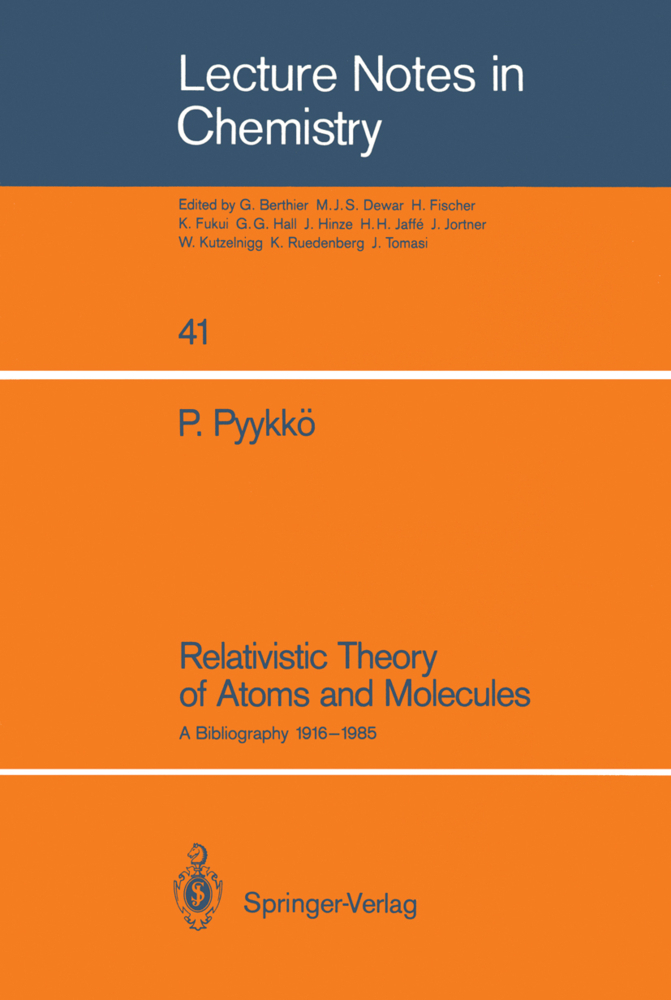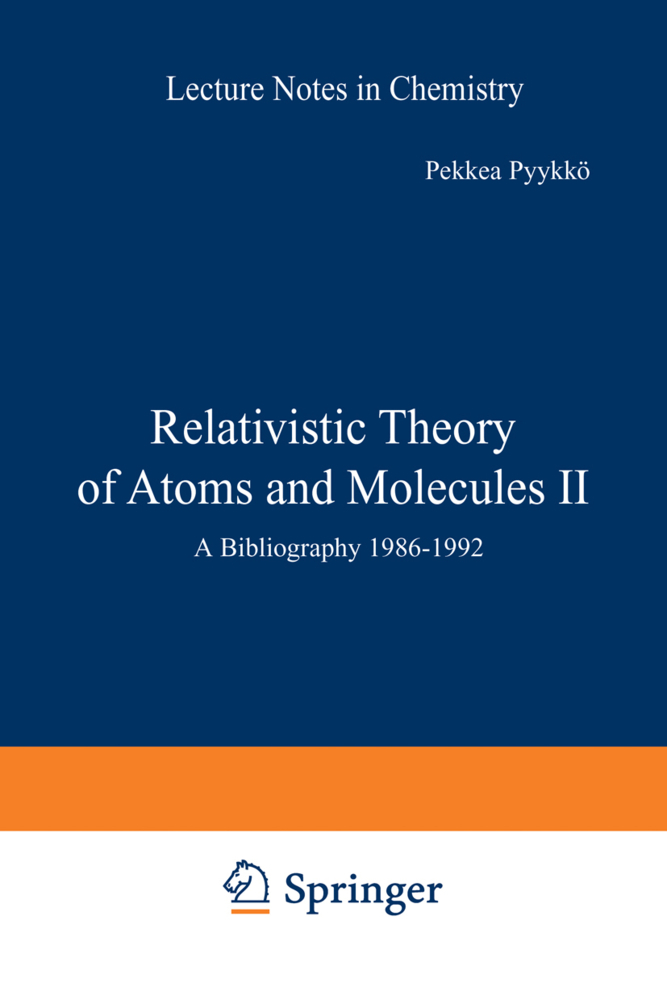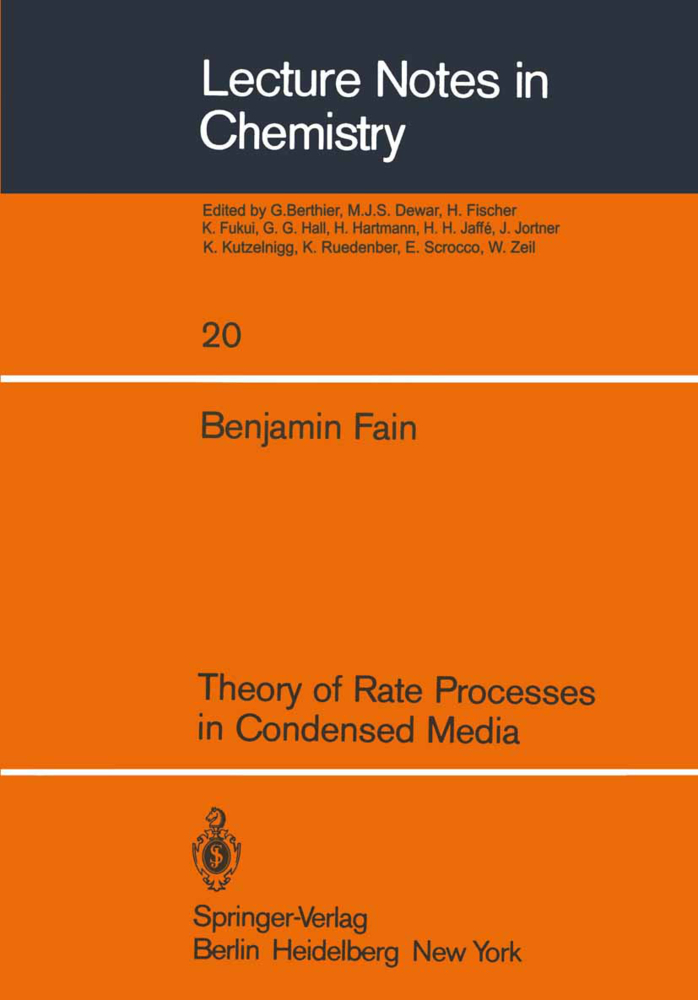A Bibliography 1916-1985
A Bibliography 1916-1985
The project that finally led to this book, was originally started with Dr. Jean-Paul Desclaux. It is a pleasure to thank hirn for a fruitful collaboration stretching over more than a decade. While accepting the responsibility for any remaining errors and omissions, I wish to acknowledge in particular the comments by Teijo Aberg, Viktor Flambaum, Burkhard Fricke, Franz Mark and Arne Rosen. The Bibliography was compiled using a Fortran program, written for the DEC 20 at the University of Turku by Matti Hotokka, and adap ted to the University of Helsinki Burroughs 7800 by Dage Sundholm. Harriet Björnström did most of the typing and Käthe Ramsay cross checked the text against the Bibliography. Readers, interested in obtaining a Wordstar-readable, IBM PC compatible diskette file (about 520 kb on a two-sided diskette) of the Bibliography should contact the author Helsinki, 20 August, 1986 Pekka Pyykkö CONTENTS 1. Introduction ................................................. 1 Table 1.1. Managraphs and ather general references ........... 2 2. One-particle problems ........................................ 5 2.1. Special relativity and the ald quantum theary ........... 5 2.2. On the Klein-Gardon equation ............................ 5 2.3. The Dirac equation ...................................... 6 Table 2.l. The Dirac equation: interpretative studies, symmetry properties and non-relativistic limits ............ 7 Table 2.2. The Dirac equation: further transformations ...... 13 Table 2.3. The Dirac equation: solutions for hydrogen-like systems. . ........................................ 1 6 Table 2.4. The Dirac equations: solutions for various n- coulomb fields. . ................................. 21 Table 2.5. Relativistic virial theorems ..................... 26 3. Quantum electrodynamical effects ............................ 27 Table 3.1.
2. One-particle problems
2.1. Special relativity and the old quantum theory
2.2. On the Klein-Gordon equation
2.3. The Dirac equation
3. Quantum electrodynamical effects
Table 3.1. Higher-order corrections: methods
Table 3.2. Higher-order corrections: hyperfine interactions
Table 3.3. Higher-order corrections: energy levels
Table 3.4. Higher-order corrections: interatomic and -molecular interactions
4. Multielectron atoms: methods
Table 4.1. General methods and basic theory for multielectron atoms
Table 4.2. Published programs for atoms
Table 4.3. Numerical, non-statistical four-component methods
Table 4.4. Four-component LCAO approaches for many-electron atoms
Table 4.5. Various four-component local-density methods
Table 4.6. Thomas-Fermi calculations
Table 4.7. Independent-particle models
Table 4.8. Definitions, reviews and background for effective potential calculations
Table 4.9. Effective-potential methods
Table 4.10. Available relativistic effective potentials
Table 4.11. One-component and perturbation calculations
Table 4.12. (1/Z- and other similar expansions for many-electron atoms
5. Multielectron atoms: results
Table 5.1. Tabulations of atomic ground-state properties
Table 5.2. Data on atomic energy levels
Table 5.3. Auger and autoionization processes
Table 5.4. Ionization potentials and electron affinities
Table 5.5. Supercritical (Z > 137) systems
Table 5.6. Electromagnetic transition probabilities
Table 5.7. Polarisabilities and screening constants
Table 5.8. Electric and magnetic hyperfine properties
Table 5.9. Average radii and magnetic g-factors
Table 5.10. Compton profiles, momentum distributions and spin densities
Table 5.11. X-ray scattering factors
Table 5.12. Electron and positron scattering
Table 5.13. Particle-atom collisions.
Table 5.14. Photon scattering and photoionization
Table 5.15. Atom-atom collisions and interatomic potentials
Table 5.16. Nuclear processes involving electronic wave functions
Table 5.17. Parity-violation effects in atoms and molecules
6. Symmetry
Table 6.1. Theory of double groups and related aspects
Table 6.2. Available data for double groups
Table 6.3. Time-reversal symmetry and related questions
7. Molecular calculations
Table 7.1. One-electron systems
Table 7.2. LCAO-DF calculations on molecules
Table 7.3. Molecules treated by the DF-OCE method
Table 7.4. Molecules treated by the DS-DVM method
Table 7.5. Molecules treated by the DS-MS X? method
Table 7.6. Molecules treated by the quasirelativistic DS-MS X? approach
Table 7.7. Molecules treated by pseudopotential methods
Table 7.8. Molecules treated by the Perturbative Hartree-Fock-Slater (P-HFS) method
Table 7.9. First-order perturbation theory on molecules
Table 7.10. Density functional calculations1
Table 7.11. Semiempirical methods
Table 7.12. Relativistic crystal field theory
Table 7.13. Relativistic theories of molecular properties
8. Solid-state theory
Table 8.1. Band-structure calculations.
9. Relativistic effects and heavy-element chemistry
Table 9.1. "Relativity and the periodic system". Periodic trends, reviews and pedagogical papers
Table 9.2. Bond lengths
Table 9.3. Dissociation and interaction energies
Table 9.4. Force constants
Table 9.5. Molecular fine-structure splittings
Table 9.6. Magnetic resonance parameters
Table 9.7. Electric dipole moments and molecular charge distributions
Table 9.8. Molecularenergy levels and energy transfer
Table 9.9. Molecular ionization potentials and electron affinities
Some comments on notations and terminology
List of acronyms and symbols.
1. Introduction
Table 1.1. Monographs and other general references2. One-particle problems
2.1. Special relativity and the old quantum theory
2.2. On the Klein-Gordon equation
2.3. The Dirac equation
3. Quantum electrodynamical effects
Table 3.1. Higher-order corrections: methods
Table 3.2. Higher-order corrections: hyperfine interactions
Table 3.3. Higher-order corrections: energy levels
Table 3.4. Higher-order corrections: interatomic and -molecular interactions
4. Multielectron atoms: methods
Table 4.1. General methods and basic theory for multielectron atoms
Table 4.2. Published programs for atoms
Table 4.3. Numerical, non-statistical four-component methods
Table 4.4. Four-component LCAO approaches for many-electron atoms
Table 4.5. Various four-component local-density methods
Table 4.6. Thomas-Fermi calculations
Table 4.7. Independent-particle models
Table 4.8. Definitions, reviews and background for effective potential calculations
Table 4.9. Effective-potential methods
Table 4.10. Available relativistic effective potentials
Table 4.11. One-component and perturbation calculations
Table 4.12. (1/Z- and other similar expansions for many-electron atoms
5. Multielectron atoms: results
Table 5.1. Tabulations of atomic ground-state properties
Table 5.2. Data on atomic energy levels
Table 5.3. Auger and autoionization processes
Table 5.4. Ionization potentials and electron affinities
Table 5.5. Supercritical (Z > 137) systems
Table 5.6. Electromagnetic transition probabilities
Table 5.7. Polarisabilities and screening constants
Table 5.8. Electric and magnetic hyperfine properties
Table 5.9. Average radii and magnetic g-factors
Table 5.10. Compton profiles, momentum distributions and spin densities
Table 5.11. X-ray scattering factors
Table 5.12. Electron and positron scattering
Table 5.13. Particle-atom collisions.
Table 5.14. Photon scattering and photoionization
Table 5.15. Atom-atom collisions and interatomic potentials
Table 5.16. Nuclear processes involving electronic wave functions
Table 5.17. Parity-violation effects in atoms and molecules
6. Symmetry
Table 6.1. Theory of double groups and related aspects
Table 6.2. Available data for double groups
Table 6.3. Time-reversal symmetry and related questions
7. Molecular calculations
Table 7.1. One-electron systems
Table 7.2. LCAO-DF calculations on molecules
Table 7.3. Molecules treated by the DF-OCE method
Table 7.4. Molecules treated by the DS-DVM method
Table 7.5. Molecules treated by the DS-MS X? method
Table 7.6. Molecules treated by the quasirelativistic DS-MS X? approach
Table 7.7. Molecules treated by pseudopotential methods
Table 7.8. Molecules treated by the Perturbative Hartree-Fock-Slater (P-HFS) method
Table 7.9. First-order perturbation theory on molecules
Table 7.10. Density functional calculations1
Table 7.11. Semiempirical methods
Table 7.12. Relativistic crystal field theory
Table 7.13. Relativistic theories of molecular properties
8. Solid-state theory
Table 8.1. Band-structure calculations.
9. Relativistic effects and heavy-element chemistry
Table 9.1. "Relativity and the periodic system". Periodic trends, reviews and pedagogical papers
Table 9.2. Bond lengths
Table 9.3. Dissociation and interaction energies
Table 9.4. Force constants
Table 9.5. Molecular fine-structure splittings
Table 9.6. Magnetic resonance parameters
Table 9.7. Electric dipole moments and molecular charge distributions
Table 9.8. Molecularenergy levels and energy transfer
Table 9.9. Molecular ionization potentials and electron affinities
Some comments on notations and terminology
List of acronyms and symbols.
Pyykö, Pekka
| ISBN | 978-3-540-17167-6 |
|---|---|
| Artikelnummer | 9783540171676 |
| Medientyp | Buch |
| Copyrightjahr | 1986 |
| Verlag | Springer, Berlin |
| Umfang | IX, 389 Seiten |
| Abbildungen | IX, 389 p. |
| Sprache | Englisch |










